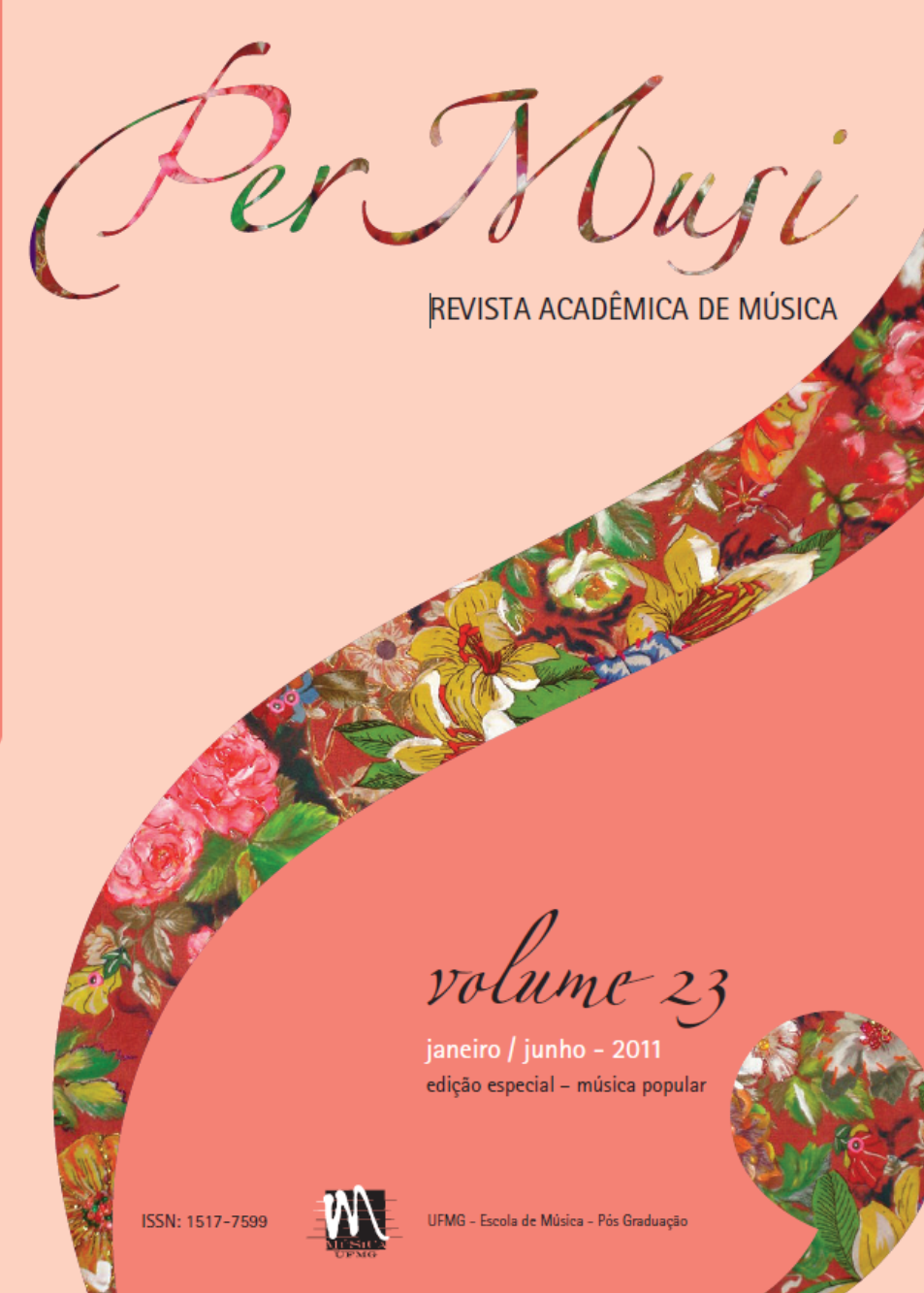Análise musical para “não-musos”
a percepção popular como base para a compreensão de estruturas e significados musicais
Palavras-chave:
análise da música popular, análise musemática, música para leigosResumo
Estudo sobre o desenvolvimento de métodos de análise da música popular, especialmente daquela voltada para ““não-musos””, ou seja, os musicalmente iletrados, a partir de referenciais semiológicos, como denotação (e conotação) poïética e estésica.
Referências
DIBBEN, N. (Palestra não publicada sobre o disco Unison de Björk, ministrada na Conference on Popular Music Analysis da University of Cardiff, País de Gales, em 2001).
GIMSON, A. C. An Introduction to the Pronunciation of English. (publicado originalmente em 1962). London: Edward Arnold, 1967.
LACASSE, S. “Listen to My Voice”: The Evocative Power of Vocal Staging in Recorded Rock Music and Other Forms of Vocal Expression. Liverpool: PhD, Institute of Popular Music, University of Liverpool, 2000.
MARTÍNEZ, J. L. Semiosis in Hindustani Music. Imatra: Acta Semiotica Fennica V., 1997.
MIDDLETON, R. Towards a theory of gesture in popular song analysis. Secondo convegno europeo di analisi musicale, ed. R Dalmonte & M Baroni. Trento: Università degli studi di Trento, Dipartimento di storia della civiltà europea, 1992. p.345-350.
RICHARDSON, J. (Palestra não publicada sobre as similaridades da sonoridade das cordas em músicas de Bernard Herrmann, Beatles, Stevie Wonder e Coolio, ministrada na Conference on Popular Music Analysis da University of Cardiff, País de Gales, em 2001).
TAGG, P. Analysing Popular Music: Theory, Method and Practice. Popular Music. v.2, 1982, p.37-69. Republicado em Reading Pop. Approaches to Textual Analysis in Popular Music. Ed. R. Middleton. Oxford University Press, 2000, p.71-103 [www.tagg.org/articles/xpdfs/pm2anal.pdf].
______. Analysing music in the media: an epistemological mess. Music on Show: Issues of Performance, ed. T Hautamäki, H Järviluoma. Tampere: Department of Folk Tradition, 1998. p.319-329 [www.tagg.org/articles/glasg95.html]. 1998.
______. Fernando The Flute. New York: The Mass Media Music Scholars’ Press (www.tagg.org/mmmsp/fernando.html).2001d.
______. High and Low, Cool and Uncool: aesthetic and historical falsifications about music in Europe. Bulgarian Musicology, 2/2001, ed. C Levy. Sofia: Bulgarska Akademiya na Naukute-Institut za izkustvoznanie: 9-18. Expanded version of homonymous paper was delivered to the IASPM (UK) conference at the University of Guildford (July 2001) [www.tagg.org/articles/iaspmuk2000.html]. 2001a
______. Kojak: 50 Seconds of Television Music. New York: The Mass Media Music Scholars’ Press (2nd edition; 1st published 1979 by Musikvetenskapliga institutionen vid Göteborgs universitet) (www.tagg.org/mmmsp/kojak.html). 2001c.
______. Music, moving image, semiotics and the democratic right to know. Article based on paper delivered at conference ‘Music and Manipulation’, Nalen, Stockholm, 18 September, 1999. [www.tagg.org/articles/xpdfs/sth9909.pdf]. 1999
______. Music’s Meanings; online draft at www.tagg.org/bookxtrax/NonMuso/NonMuso.pdf. 2009a.
______. Musicology and the Semiotics of Popular Music. Semiotica, v.66-1/3, 1987. p.279-298 [www.tagg.org/articles/xpdfs/semiota.pdf]. 1987.
______. Notes on how classical music became “classical”. [www.tagg.org/teaching/classclassical.pdf]. 2000a.
______. Twenty Years After. Speech delivered at Founder’s Event, 11th International IASPM Conference, Turku, 8 July 2001 [www.tagg.org/articles/turku2001.html]. 2001b.
______. Vers une musicologie de la télévision. Frank Martin, musique et esthétique musicale. Actes du colloque de LaChaux-de-Fonds 1990, Ed. É Émery. Revue Musicale de Suisse romande, 1995. p.33-60 [www.tagg.org/articles/gonseth.html]. 1995
TAGG, P.; CLARIDA, R. Ten Little Title Tunes. New York: The Mass Media Music Scholars’ Press (www.tagg.org/mmmsp/10Titles.html). 2003.
TAMLYN, G. The Big Beat: Origins and development of snare backbeat and other accompanimental rhythms in Rock ‘n’ Roll. 1998, Liverpool: University of Liverpool, PhD Thesis, Institute of Popular Music. 1998.
Referências de áudio
HARRISON, George. My Sweet Lord: Apple R5884 (UK). 1971.
NORMAN, Monty. ‘Dr No’ – main titles (the ‘James Bond Theme’). In Dr No: MGM / UA Home Video.
PES 99210 (1992). On The Best of Bond: UA UAS 29021 (1975) and on Il terzo uomo e altri celebri film: RCA Cinematre NL 43890 (n.d.). 1962.
THE CHIFFONS. He’s So Fine: Stateside SS 172 (UK). Also on Legends of Rock’n’Roll. Tring TTMC 088 (n.d., c.1994). 1963.
THE EDWIN HAWKINS SINGERS. Oh Happy Day: Pavillion 20001 (US); Buddah 201048 (UK). Also on 20 Heavy Hits, Crystal S-600. 1969.
THE SOURCE FEATURING CANDI STATON. ‘You Got The Love — “Now Voyager” mix’. On Pure Dance ‘97. Polygram TV 555 084-2. 1991.
Arquivos adicionais
Publicado
Edição
Seção
Licença

Este trabalho está licenciado sob uma licença Creative Commons Attribution 4.0 International License.

Exceto onde está indicado, o conteúdo neste site está sob uma Licença Creative Commons - Atribuição 4.0 Internacional.












